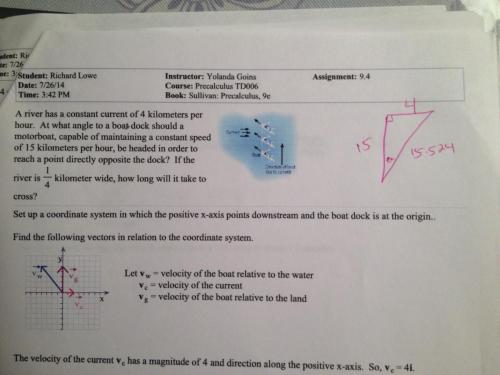-
Posts
13 -
Joined
-
Last visited
Retained
- Lepton
Recent Profile Visitors
The recent visitors block is disabled and is not being shown to other users.
Moriarty's Achievements

Quark (2/13)
10
Reputation
-
Thank you for sharing.
-
There we go. I knew this was easy. What you've done is attack this problem the same way my text does, but with a much more straightforward approach that I like. For example, my text would create an equation that would lead to finding the direction of the boat relative to the water thus: Vc = 4i (water current) Vw = ai + bj, so ||Vw|| = sqrt(a^2 + b^2) Vg = Vw + Vc (from the diagram above) kj = ai + bj + 4i, where k is the magnitude of the vector Vg, so kj = (a +4)i + bj, noting that for this equation to be true, the coefficients of the i and j components must be equal on both sides. Solving, a = -4 and b = sqrt(209), so Vw = -4isqrt(209)j and Vg = kj = sqrt(209)j We then find angle theta between Vw and Vg: COS theta = the dot product of Vw and Vg divided by ||VW|| ||VG|| = .9638, or 15.5 degrees. It's functional, but I wouldn't consider it efficient when I can just draw a right triangle and be done with it. At least now I can, so thanks! I also see why my first attempt flubbed..
-
Thanks, I'll play around with this tonight and let you know. Appreciate it!
-
I'm not being uncooperative. I missed your question. Triangle, but that's a secret. Please keep it between us. But by all means, confuse me. The more perspective, the more information, the greater the odds that I'll leave with what I came for.
-
Maybe it would help to say I'm asking this question because I'm bothered by the problem. The class is complete and final grades have been posted. I got an A. Great. In most cases, I was able to kind of "dissect" problems to better understand them, which allowed me to approach them from new directions if I found myself stuck on something. In the case of vectors this never quite happened and I had to simply follow the steps. My particular frustration is in not understanding how these moving parts are connected and how they influence an outcome. I'd like to get this under my belt before I move on to the next course because I feel I couldn't properly formulate a real problem, as evidenced above. I saw your reply above and thanks for that. Let me ask this question: if, hypothetically, the longitudinal axis of the boat were not going to turn left or right..as in the bow would remain perpindicular to the x axis..how might I find out where the boat would land on the opposite bank if no effort were made to correct the course? I think if I could to that correctly, I'd be on the path to understanding this. Thanks.
-
That answers question 1, thanks. As I mentioned, I suspected this was the case, but am trying to understand why. I can solve the problem and get the correct result, but that doesn't mean I truly understand everything that's happening. My response to this problem is purely robotic if I want to get the correct answer, yet I don't truly understand the nature of the problem. I'd like to. I don't see that as picking holes in it, personally.
-
Hi everyone, First, let me say I can actually solve this problem without trouble using the prescribed method. I just don't like it, think it's kind of clunky and have been wondering about another way to go at it. Something more intuitive to me. As you can see from the pic, the problem to solve is pretty straightforward. What I was wondering is what would happen if the boat were to *not* compensate for the river current at all? Where would it end up? The triangle I drew up in the corner kind of illustrates what I think would happen. 15 represents the speed of the boat along the Y axis, and 4 is the perpindicular force acting upon it by the river current. Calculating the angle theta I think the boat would drift about 14.9 degrees to the right. So my questions are: 1. Is my assumption above correct, or am I misrepresenting what's happening? (I suspect so, but don't know why) 2. If my assumtion is correct, then why couldn't the boat steer 14.9 degrees to the left of the Y axis to compensate for the current? (The correct answer is 15.5) 3. I noted that the hypotenuse of the triangle I drew happened to measure 15.5. Is this a coincidence, or is there a connection between this and the correct answer to the problem, which is also 15.5? Thanks!
-
Link Link This research appears to be application-driven, but I'm personally more interested in the fact that the phenomenon occurs at all and only when the light is confined (compressed? excited?) within a nano scale. Electron degeneracy comes to mind for some reason, although unrelated. I'd appreciate someone pointing me to some resources so I might better understand how this works. Specifically, I wasn't aware light could have attractive or repulsive properties.
-
Ahh, now the Okie gets it. Many thanks.
-
Thanks for your insights, guys. Appreciate the time.
-
Thanks for the reply. I'm with you so far. I don't yet understand the why, but I'll get there. If you're saying there is no measurable difference between a photon and it's anti-particle (itself?), then I follow. However...why call it an anti-particle? Do photons actively annihilate one another like electrons/ positrons? If not, how is the interaction different? My real confusion here is in figuring out why some of these force carriers are considered their own anti-particles. Hope my questions make sense. Did you intentionally skip my graviton question? Thanks again.
-
I've been working recently on my understanding of the Standard Model. I was fine (more or less) until I got to the force carriers, which is where my understanding seems to really break down. My questions: 1. How can a particle be its own anti-particle, eg, Z particle, photons, gluons and gravitons? What do you get if two photons annihilate with one another...another pair of photons? 2. Is there any experimental data short of direct observation to support the existence and modeling of the graviton, or does it simply serve as a placeholder in an attempt to complete the standard model until better information comes along? Thanks in advance. I'm certain to have more questions later.
-
Hi everyone. I'm a 35 year old Air Traffic Controller, amateur astronomer, and general "space stuff" and math enthusiast. I also have a passing interest in chemistry (having learned just enough to better understand my astro hobby). I've been a lurker for a while, so thought I'd pass a note of appreciation to the staff and meaningfully contributing members of this site: thanks for your time and energy.



